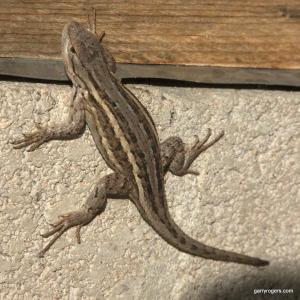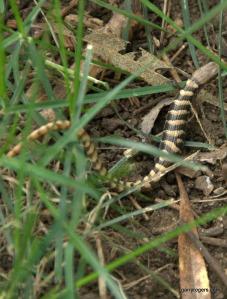Almost half the lizard species found in the U. S. are present in Arizona. They are a colorful group with fascinating life histories. Lizards help control ants, termites, and other insects, and with only one exception, the Gila Monster, they are not venomous. Field guides are available online (Arizona Herpetological Association, Brennan, 2008), and in print (Jones and Lovich, 2009, and Stebbins, 1966).

Plateau Fence Lizard
The photograph shows a Plateau Fence Lizard. These lizards do like fences, but they will sit on any convenient object that gives them an elevated view. They are found throughout central and northern Arizona.
Lizards are not descended from dinosaurs. They appeared about the same time and lived with dinosaurs, but they are not closely related. Lizard legs extend to the sides of the body rather than projecting downward or forward. Lizards became a separate group in the Late Triassic, over 200 million years ago.
______________
Children like lizards almost as much as they like turtles. Lizards are not as easy to play with, but they are very brave and colorful, and some are easy to catch. If you haven’t tried to pick up a ground hugging Horned Lizard (aka Horny Toad), or seen one squirt blood from its eyes you’ve missed out on two of life’s finest experiences. It’s hard to imagine how blood squirting evolved as a defense, but I’ve read that the blood is distasteful to some predators. When threatened, Horned Lizards and many other lizard species puff up their bodies and do pushups to appear larger and scarier. Some lizards have replaceable tails. When cornered, they wave their tails to lure predators into striking that detachable and replaceable appendage.

Arizona Alligator Lizard (Elgaria kingii)
Newly-hatched lizards have to begin hunting food immediately. Only the young of a few skink species receive any parental care, and then not much. A tiny tree lizard less than one inch long, will investigate every small object it finds. Since anything might be dangerous instead of delicious, these tiny creatures will approach a twig, pebble, or clod of dirt, do some pushups, and then try a bite. Tiny slugs, ants, and other small arthropods are what they need. Bite-sized morsels themselves, most baby lizards don’t grow up. Those that do join the ranks of one of our most important regulators of bug populations.
Lizard Numbers
(Numbers from Gibbons et al. (2000) and AZGFD (2012). The Arizona numbers include subspecies and sub populations).
- World: ≈5,000
- United States: >100
- Arizona total lizard species: 69
- Arizona native lizards species: 67
- Arizona lizards imperiled, vulnerable, or possible long-term concern: 39 (58%)
- ESA Arizona Lizards of Concern: 11 (16%)
Arizona Lizard Conservation
Almost all of Arizona’s lizard species are declining in response to human developments. Roads, houses, pesticides, invasive species, wildfire, energy development and transmission, and more human activities are steadily eroding their numbers. Species such as the Horned Lizards have almost no ability to survive their encounters with people. Easily captured, they are often taken as pets or specimens, an experience they often do not survive.
Further information on conservation is available on the Internet sites listed in the references. The PARC (Partners in Amphibian and Reptile Conservation) website provides access to special reports and newsletters containing interesting information about lizards. A good discussion of lizard conservation is provided in the book by Jones and Lovich (2009).
Arizona Lizard References
- AZGF (Arizona Game and Fish Department): http://www.azgfd.gov.
- Arizona Herpetological Association: http://www.azreptiles.com.
- Brennan, T.C. 2008. Online field guide to reptiles and amphibians of Arizona: http://www.reptilesofaz.com/.
- Gibbons, J.W., D.E. Scott, T.J. Ryan, K.A. Buhlmann, T.D. Tuberville, B.S. Metts, J.L. Greene, T. Mills, Y. Leiden, S. Poppy, and C.T. Winne. 2000. The global decline of reptiles, déjà vu amphibians. BioScience 50: 653-666.
- International Reptile Conservation Fund: http://www.ircf.org/.
- Jones, L.L.C., and R.E. Lovich, eds. 2009. Lizards of the American Southwest: A photographic field guide. Rio Nuevo Publishers, Tucson, AZ. 567 p.
- PARC (Partners in Amphibian and Reptile Conservation): http://www.parcplace.org/.
- Stebbins, R.C. 1966. A field guide to western reptiles and amphibians. Houghton Mifflin, Boston, MA. 279 p.
Arizona Lizard Conservation Status Symbols (from AZGFD)
Symbols used by Arizona Game and Fish Department (AZGFD)
- S1 Critically Imperiled: Extremely rare or some factor(s) is making the species especially vulnerable to extirpation. Typically 5 or fewer locations or very few remaining individuals (<1,000).
- S2 Imperiled: Rare or some factor(s) is making the species very vulnerable to extirpation. Typically 6 to 20 occurrences or few remaining individuals (1,000 to 3,000).
- S3 Vulnerable: Rare or found only in a restricted range (even if abundant at some locations), or because of other factors making it vulnerable to extirpation. Typically 21 to 100 occurrences or between 3,000 and 10,000 individuals.
- S4 Apparently Secure: Uncommon but not rare, and usually widespread. Usually more than 100 occurrences* and more than 10,000 individuals. Possible long-term concern.
- S5 Secure: Common, widespread, and abundant. Safe under present conditions. Typically with considerably more than 100 locations and more than 10,000 individuals.
- S? Status unknown.
- S#S#: Indicates the range of uncertainty about exact status (e.g., S3S4).
- E: Exotic Origin: Species is not native to AZ.
Symbols Used for the Endangered Species Act (ESA)
(US Department of Interior, Fish and Wildlife Service)
- SC Species of Concern: Describes the entire realm of taxa whose conservation status may be of concern to the US Fish and Wildlife Service, but does not have official federal status.
A R I Z O N A L I Z A R D S
SCIENTIFIC NAME
COMMON NAME
AZ
ESA
Aspidoscelis arizonae
Arizona Striped Whiptail
S1S2
Aspidoscelis exsanguis
Chihuahuan Spotted Whiptail
S2
Aspidoscelis flagellicauda
Gila Spotted Whiptail
S4
Aspidoscelis inornata
Little Striped Whiptail
SRF
Aspidoscelis neomexicana
New Mexico Whiptail
S?
Aspidoscelis pai
Pai Striped Whiptail
S1
Aspidoscelis sonorae
Sonoran Spotted Whiptail
S5
Aspidoscelis stictogramma
Giant Spotted Whiptail
S2
SC
Aspidoscelis tesselata
Common Checkered Whiptail
S?
Aspidoscelis tigris
Tiger Whiptail
S5
Aspidoscelis uniparens
Desert Grassland Whiptail
S5
Aspidoscelis velox
Plateau Striped Whiptail
S5
Aspidoscelis xanthonota
Redback Whiptail
S2
SC
Callisaurus draconoides
Zebra-tailed Lizard
S5
Coleonyx variegatus
Western Banded Gecko
S5
Coleonyx variegatus bogerti
Tucson Banded Gecko
S?
Coleonyx variegatus variegatus
Desert Banded Gecko
S?
Cophosaurus texanus
Greater Earless Lizard
S5
Cophosaurus texanus scitulus
Chihuahuan Greater Earless Lizard
S5
Crotaphytus bicinctores
Great Basin Collared Lizard
S4
Crotaphytus collaris
Eastern Collared Lizard
S5
Crotaphytus nebrius
Sonoran Collared Lizard
S3S4
Ctenosaura pectinata
Western Spiny-taled Iguana
SE
Dipsosaurus dorsalis
Desert Iguana
S5
Elgaria kingii
Madrean Alligator Lizard
S5
Elgaria kingii nobilis
Arizona Alligator Lizard
S5
Gambelia wislizenii
Long-nosed Leopard Lizard
S5
Heloderma suspectum
Gila Monster
S4
Heloderma suspectum cinctum
Banded Gila Monster
S4
SC
Heloderma suspectum suspectum
Reticulate Gila Monster
S4
Hemidactylus turcicus
Mediterranean Gecko
SE5
Holbrookia maculata
Common Lesser Earless Lizard
S5
Phrynosoma cornutum
Texas Horned Lizard
S3S4
SC
Phrynosoma goodei
Goode’s Horned Lizard
S3S4
Phrynosoma hernandesi
Greater Short-horned Lizard
S4
Phrynosoma mcallii
Flat-tailed Horned Lizard
S2
SC
Phrynosoma modestum
Round-tailed Horned Lizard
S3
Phrynosoma platyrhinos
Desert Horned Lizard
S5
Phrynosoma platyrhinos calidiarum
Southern Desert Horned Lizard
S5
Phrynosoma solare
Regal Horned Lizard
S5
Plestiodon “gilberti”
Gilbert’s Skink
S3S4
Plestiodon “gilberti” rubricaudatus
Western Red-tailed Skink
S3S4
Plestiodon callicephalus
Mountain Skink
S2
Plestiodon multivirgatus
Many-lined Skink
S3S4
Plestiodon multivirgatus epipleurotus
Variable Skink
S3S4
Plestiodon obsoletus
Great Plains Skink
S5
Plestiodon skiltonianus
Western Skink
S1
Sauromalus ater
Common Chuckwalla
S4
SC
Sauromalus ater (Arizona Population)
Arizona Chuckwalla
S4
SC
Sauromalus ater (Glen Canyon Population)
Glen Canyon Chuckwalla
S2?
SC
Sauromalus ater (Western Population)
Western Chuckwalla
S4
SC
Sceloporus clarkii
Clark’s Spiny Lizard
S5
Sceloporus graciosus
Common Sagebrush Lizard
S3S4
Sceloporus graciosus graciosus
Northern Sagebrush Lizard
S3S4
SC
Sceloporus jarrovii
Yarrow’s Spiny Lizard
S5
Sceloporus magister
Desert Spiny Lizard
S5
Sceloporus slevini
Slevin’s Bunchgrass Lizard
S2
Sceloporus undulatus
Fence/Prairie/Plateau Lizard
SRF
Sceloporus virgatus
Striped Plateau Lizard
S3
Uma notata
See: Uma rufopunctata
SRF
Uma rufopunctata
Yuman Desert Fringe-toed Lizard
S2
SC
Uma scoparia
Mohave Fringe-toed Lizard
S1
Urosaurus graciosus
Long-tailed Brush Lizard
S5
Urosaurus ornatus
Ornate Tree Lizard
S5
Uta stansburiana
Common Side-blotched Lizard
S5
Uta stansburiana elegans
Western Side-blotched Lizard
S3
Xantusia arizonae
Arizona Night Lizard
S1
Xantusia bezyi
Bezy’s Night Lizard
S2
Xantusia vigilis
Desert Night Lizard
S4
Google+


